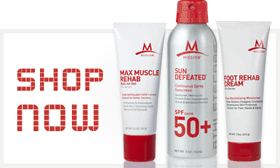
As the editor of Mission's blog, I have the job of figuring out what comes next. Given that the Olympics are around the corner, we at Mission will be checking in with some of our athletes to talk training - a topic that many of you are interested in. Via Facebook and Twitter, you've shared news of your latest race, upcoming season, and personal fitness goals. In fact, more often than not, one of your comments leads me to a workout of my own later on in the day... But back to the Mission athletes. I figure their secrets will benefit us all. Before we jump in with their favorite workouts and tricks of the trade, I wanted to write a post about the preparation needed before one even begins training. Baby steps, if you will.
Before considering which race to sign up for this spring, I spent some time searching the web for sources that deal with the importance of training and came across a wide variety of opinions. The articles that I have included here offered some of the best advice, in part because they spoke to the fundamentals of training as an everyday endeavor for the everyday athlete.
In an article for xtri.com, Brad Stulberg breaks World Champion triathlete, Jordan Rapp's quote, "train as much as possible" into two parts. He writes:
"1) Train as much: More volume and more intensity is good, so long as...
2) As Possible: The body and mind are in a position to successfully adapt to the applied load."
His article, available here, made me reconsider the feet to the fire approach I initially thought was necessary to start training. The idea isn't to ambush your body. It is to first, be thoughtful, and second, act accordingly. As Stulberg writes, we, the training athletes, need to consider the rest of our lives - the amount of time we spend at work, the amount of time we sleep, the amount of time we would have to recover after working out - before we can commit to a training regimen. I completely agree.
Tip 1: Be realistic.
I found more valuable insight at the New York Times and Tara Parker-Pope's blog on health and wellness (one of my go-tos for insight re: fitness, health, food and the intersection of the three) where Nicole Kolata was writing about the limits of personal workouts.
Kolata sat down with University of Indiana's sports psychologist, John Raglin, to talk about a recent trend and the focus of his studies, overtraining. Raglin's advice to the everyday athlete is to take notice of your body. "You should feel tired... but if you do too much with too little rest, your performance gets worse, not better. Serious athletes recognize these issues — whether they respond to them or not is another matter. A lot of recreational athletes really have no idea.”
If you're not sure how to keep your workouts in perspective, Kolata suggests writing in a diary or taking notes on how you feel after training. The act of recording will help you stay atune to what your body may be telling you.
Rule 2: Take time to recover.
Rule 2.5: Take notes.
A little late to the race, I stumbled across ESPN anchor, Sage Steele's blog about preparing for her first half-marathon. (You can follow her on Twitter by searching #RUNSAGE.) In the latest entry, two trainers - both marathon runners and moms - Dimity McDowell and Sarah Bowen Shea, give her some "sage advice," beginning with:
1. Don't think, just go. (For their other tips, read the rest of the article here.)
Perhaps more than anything, you and I, just have to start. Lace up the old Nikes and get out there. Reading these articles was step one. Onto step two and the actual running!
Stay tuned in the coming months as I'll be writing about our athletes as many of them gear up for the Olympics. I'll let you in on their training secrets and the Mission products they're using to keep them in prime condition. I welcome any of your suggestions as to what comes next. To stay in touch, visit our Connect page here.
Now, back to training!



